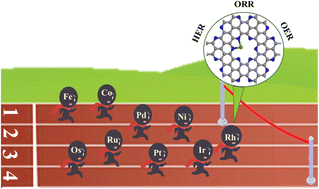Theoretical prediction of emerging high-performance trifunctional ORR/OER/HER single-atom catalysts: transition metals anchored into π–π conjugated graphitic carbon nitride (g-C10N3)
Abstract
The design of high-performance trifunctional oxygen reduction/oxygen evolution/hydrogen evolution reactions (ORR/OER/HER) electrocatalysts has become the current research focus. In this work, we report a series of single-atom catalysts formed by nine kinds of transition metal (Fe, Co, Ni, Ru, Rh, Pd, Os, Ir, and Pt) anchored in g-C10N3 (namely TM@g-C10N3) as promising trifunctional electrocatalysts to replace precious metal catalysts by density functional theory methods. All TM@g-C10N3 have good thermodynamic and electrochemical stability. Especially, Rh@g-C10N3 and Ir@g-C10N3 exhibit extremely low ORR/OER overpotentials with the values of 0.26/0.28 V and 0.34/0.41 V, respectively. Besides, their hydrogen adsorption free energy values are close to Pt(111), with their values being 0.16 and −0.16 eV, respectively. The calculated results indicate that Rh@g-C10N3 and Ir@g-C10N3 can become trifunctional electrocatalysts with great probability. Through the analysis of the dynamic mechanism for Rh@g-C10N3, it can be concluded that the four-electron ORR pathway is more conducive to occurring on Rh@g-C10N3 because the energy barrier forming this pathway is lower. Besides, the step of *OH + H+ + e− → * + H2O has the highest energy barrier in dynamics, which is consistent with this step being a potential determining step in thermodynamics. Ultimately, the solvation effect considered has little effect on the catalytic performance of screened Rh@g-C10N3 and Ir@g-C10N3, and even at a high temperature of 500 K, the structures of these two catalysts have no significant distortion after 2 ps simulations. Our calculations will provide clear guidance for future experimental synthesis and design of such catalysts.



 Please wait while we load your content...
Please wait while we load your content...